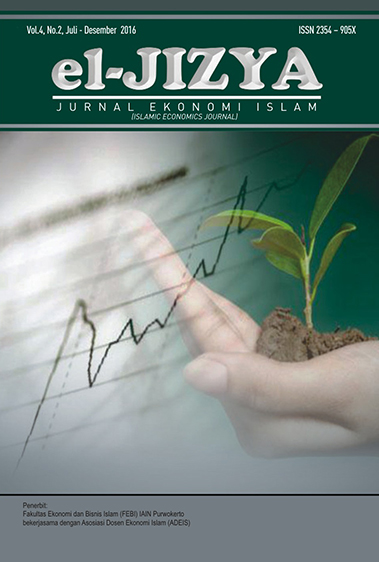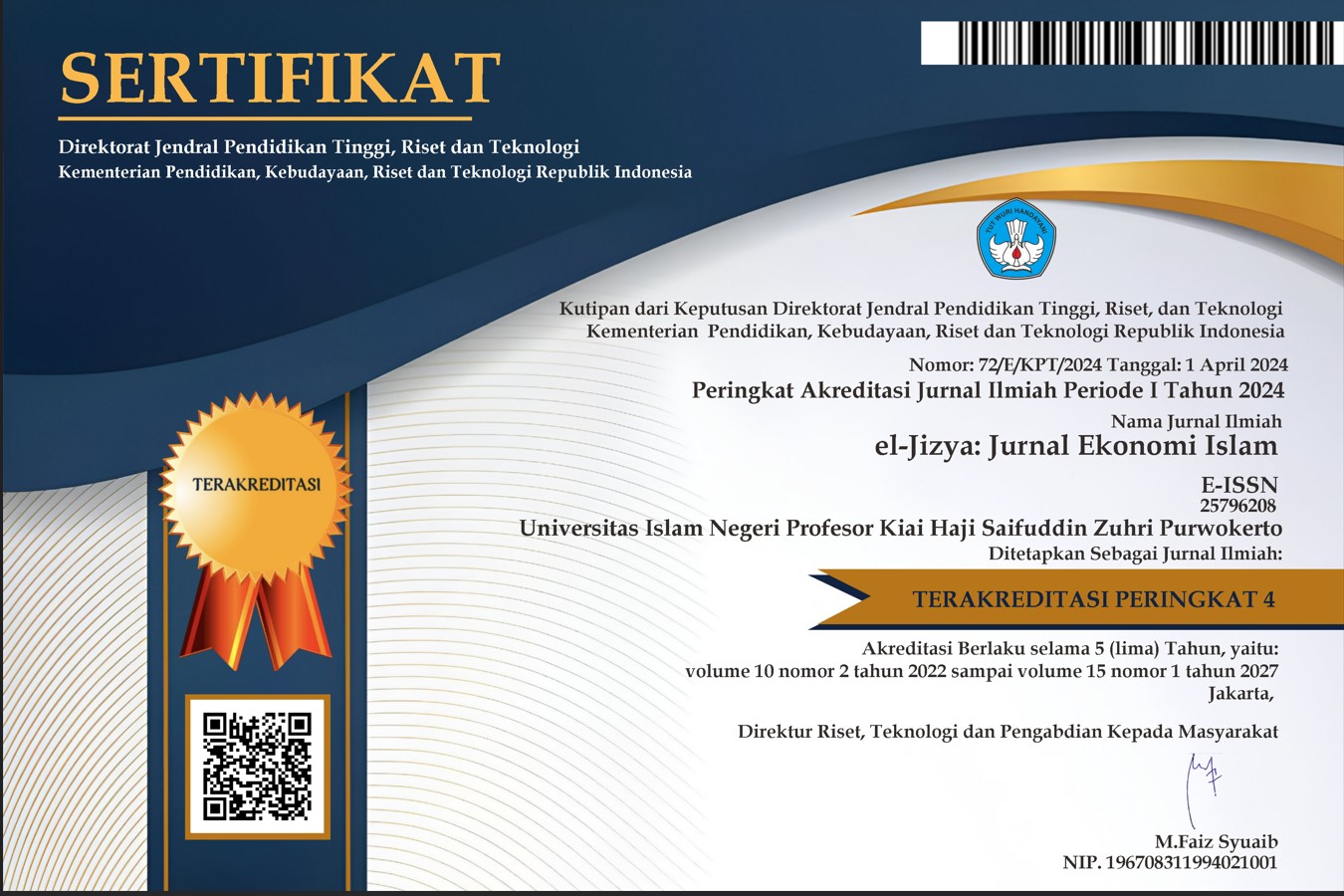Pengaruh Motivasi, Persepsi dan Internalisasi Standar ISO 9001 terhadap Kinerja
DOI:
https://doi.org/10.24090/ej.v4i2.2016.pp317-344Keywords:
Motivation, Perception, internalization of ISO Standards, PerformanceAbstract
Penelitian ini berjudul “Pengaruh Motivasi, Persepsi Dan Internalisasi Standar ISO 9001 Terhadap Kinerja pada PT. Holcim Indonesia Tbk Cilacap. Tujuan penelitian ini adalah untuk menganalisis pengaruh motivasi, persepsi dan internalisasi standar ISO 9001 terhadap kinerja. Hipotesis penelitian ini adalah pertama motivasi penerapan standar ISO 9001 berpengaruh positif dan signifikan terhadap persepsi penerapan standar ISO 9001. Kedua motivasi penerapan standar ISO 9001 berpengaruh positif dan signifikan terhadap internalisasi standar ISO 9001. Ketiga motivasi penerapan standar ISO 9001 berpengaruh positif dan signifikan terhadap kinerja. Keempat persepsi penerapan standar ISO 9001 berpengaruh positif dan signifikan terhadap kinerja. Kelima internalisasi standar ISO 9001 berpengaruh positif dan signifikan terhadap kinerja. Penelitian ini merupakan penelitian survei yang mengambil data dengan kuesioner. Sasaran penelitian adalah karyawan PT. Holcim Indonesia Tbk Cilacap Populasi dalam penelitian ini adalah semua karyawan di departemen PT. Holcim Indonesia Tbk Cilacap, sedangkan metode pengambilan sampelnya yaitu Probability Sampling dan jumlah sampel yang memenuhi syarat dalam penelitian ini sebanyak 143 orang. Alat analisa data yang digunakan dalam penelitian ini adalah Structural Equation Modelling (SEM) melalui program Analysis of Moment Structure (AMOS) versi 16.0. Sedangkan pengukuran data menggunakan 7 skala likert This study was aimed at analyzing the influence of motivation, perception, and internalization of ISO 9001 standard on the performance of PT Holcim Indonesia Tbk Cilacap. There are five hypothesa of this study, i.e: 1) the motivation of applying ISO 9001 standard has a positive and significant impact to the perception on applying ISO 9001 standard; 2) the motivation of applying ISO 9001 standard has a positive and significant impact to; 3) the motivation of applying ISO 9001 standard has a positive and significant impact to the performance; 4) the perception on applying ISO 9001 standard has a positive and significant impact to the performance; 5) the internalization of ISO 9001 standard has a positive and significant impact to the performance. This is a survey research the data of which was gained through questionaires. The respondents of this research were emplyoees of PT> Holcim Indonesia Tbk Cilacap and sampling technique used in this research was probabiliy sampling fulfilling the requirement of 143 orang. Data were analyzed with Structural Equation Modelling (SEM) using version 16.0 of Analysis of Moment Structure (AMOS) and data measurement used a Likert scale of 7.References
Abraham, M., Crawford, J., Carter, D., Mazotta, F. 2000. “Management Decisions For Effective ISO 9000 Accreditationâ€. Management Decision, Vol. 38, No. 3, pp. 182-193.
Anderson, M. & Sohal, A.S. 1999. A Study Of The Relationship Between Quality Management Practices And Business Performance In Small Businesses. International Journal of Quality and Reliability Management, Vol. 16, No.9, p859-877.
Arauz, R. and Suzuki, H., 2004. ISO 9000 Performance In Japanese Industries. Total Quality Management & Business Excellence, 15, 3–33.
Buttle, F., 1997. ISO 9000: Marketing Motivations And Benefits. International Journal of Quality & Reliability Management, 14, 936–947.
Boiral, O., 2003. ISO 9000: Outside The Iron Cage. Organization Science, 14, 720–737.
Carlsson, M. and Carlsson, D., 1996. Experiences of Implementing ISO 9000 in Swedish industry. International Journal of Quality & Reliability Management, 13, 36–47.
Corbett, C.J., Montes-Sancho, M.J., and Kirsch, D.A., 2005. The Financial Impact Of ISO 9000 Certification In The United States: An Empirical Analysis. Management Science, 51, 1046–1059.
Davenport, Thomas H. And James E. Short. 1990. The New Industrial Engineering: Information Technology and Business Process Redesign. Sloan Management Review, Summer, pp.11-27.
DiMaggio, P.J. and Powell, W.W., 1983. The Iron Cage Revisited: Institutional Isomorphism And Collective Rationality In Organizational Fields. American Sociological Review, 48, 147–160
Elmuti, D. and Kathawala, Y., 1997. An Investigation Into the Effect of ISO 9000 on Participants’ Attitudes and Job Performance. Production and Inventory Management Journal, 38, 52–55.
Forza, C.1995. Quality Information Systems and Quality Management. Industrial Management & Data Systems, 95(2), pp.1-20.
Huarng, F., Horng, C., and Chen, C., 1999. A Study Of ISO 9000 Process, Motivation And Performance. Total Quality Management, 10, 1009–1025.
Jasni Abdul Latif and Hazman Shah Abdullah. 2003. ISO 9000 Implementation And Perceived Organisational Outcome The Case Of A Service Organisation. Asian Academy of Management Journal, Vol. 8, No. 2, 91–107.
Jones, R., Arndt, G., and Kustin, R., 1997. ISO 9000 Among Australian Companies: Impact Of Time And Reasons For Seeking Certification On Perceptions Of Benefits Received. International Journal of Quality & Reliability Management, 14, 650–660.
Kretiner, R., & Kinicki, A. 1998. Organizational Behavior (4 ed.). Boston: Irwin McGraw-Hill.
Luthans, F. 1998. Organisational Behaviour. 8th ed. Boston: Irwin McGraw-Hill.
Matlin, Margaret W. 1998, Cognition, 4th Edition., New York: Harcourt Brace College Publisher.
Meyer, J.W. and Rowan, B., 1977. Institutional Organizations: Formal Structure as Myth And Ceremony. American Journal of Sociology, 83, 340–363.
Mitchell, T. R. 1982. Motivation: New Direction for Theory, Research, and Practice. Academy of Management Review, 81.
Naveh, E. and Marcus, A., 2005. Achieving Competitive Advantage Through Implementing a Replicable Management Standard: Installing And Using ISO 9000. Journal of Operations Management, 24, 1–26.
P. Padma, L. S. Ganesh and C. Rajendran. 2006. A Study On The Critical Factors Of ISO 9001:2000 And Organizational Performance Of Indian Manufacturing Firms. Revision received April 2006. Department of Management Studies, Indian Institute of Technology Madras, Chennai-600036, India, 1–31.
Rahman, S. 2001. Total Quality Management Practices and Business Outcome: Evidence From Small And Medium Enterprises in Western Australia. Total Quality Management, Vol. 12, No.2, p201-210.
Rao, S.S., Ragu-Nathan, T.S., and Solis, L.E., 1997. Does ISO 9000 Have An Effect On Quality Management Practices? An International Empirical Study. Total Quality Management, 8, 333–346.
Robbins, Stephen P. & Timothy A. Judge. 2007, Organizational Bihavior, 12th, New Jersey: Pearson Educational Inc.
Schneider, B. and Bowen, D.E. 1992. Personnel Human Resources Management In The Service Sector. Res. in Pers. Human Resource Manage., 1992, 10, 1 30.
Sekuler, R. & Blake, R.. 1985, Perception, 1st. ed., New York, Knopt, 1. Siegel, Gary & Helena Ramanauskan – Markoni. 1989, Bihavioral Accounting, Cincinnati, Ohio: South - Western Publishing Co.
Sun, H. 2000. “Total Quality Management, ISO 9000 Certification and Performance Improvementâ€, International Journal of Quality & Reliability Management, Vol. 17, No. 2, pp. 168-179.
Sureshchandar, G.S., Rajendran, C. and Anantharaman, R.N. 2001. A Holistic Model For Total Quality Service. Int. J. Service Indust. Manage., 12, 378–412.
Tan & Hunter, 2002. The Repertory Girl Technique: A Method for Study of Cognition in Information System, MIS Quarterly, 20 (1).
Vroom, V. H. 1964. Work and motivation. New York: Wiley.
Williams, J.A., 2004. The Impact Of Motivating Factors On Implementation Of ISO 9001: 2000 Registration Process. Management Research News, 27, 74–84.
Yahya, S. and Goh, W.K., 2001. The Implementation Of An ISO 9000 Quality System. International. Journal of Quality & Reliability Management, 18, 941–966.
Anderson, M. & Sohal, A.S. 1999. A Study Of The Relationship Between Quality Management Practices And Business Performance In Small Businesses. International Journal of Quality and Reliability Management, Vol. 16, No.9, p859-877.
Arauz, R. and Suzuki, H., 2004. ISO 9000 Performance In Japanese Industries. Total Quality Management & Business Excellence, 15, 3–33.
Buttle, F., 1997. ISO 9000: Marketing Motivations And Benefits. International Journal of Quality & Reliability Management, 14, 936–947.
Boiral, O., 2003. ISO 9000: Outside The Iron Cage. Organization Science, 14, 720–737.
Carlsson, M. and Carlsson, D., 1996. Experiences of Implementing ISO 9000 in Swedish industry. International Journal of Quality & Reliability Management, 13, 36–47.
Corbett, C.J., Montes-Sancho, M.J., and Kirsch, D.A., 2005. The Financial Impact Of ISO 9000 Certification In The United States: An Empirical Analysis. Management Science, 51, 1046–1059.
Davenport, Thomas H. And James E. Short. 1990. The New Industrial Engineering: Information Technology and Business Process Redesign. Sloan Management Review, Summer, pp.11-27.
DiMaggio, P.J. and Powell, W.W., 1983. The Iron Cage Revisited: Institutional Isomorphism And Collective Rationality In Organizational Fields. American Sociological Review, 48, 147–160
Elmuti, D. and Kathawala, Y., 1997. An Investigation Into the Effect of ISO 9000 on Participants’ Attitudes and Job Performance. Production and Inventory Management Journal, 38, 52–55.
Forza, C.1995. Quality Information Systems and Quality Management. Industrial Management & Data Systems, 95(2), pp.1-20.
Huarng, F., Horng, C., and Chen, C., 1999. A Study Of ISO 9000 Process, Motivation And Performance. Total Quality Management, 10, 1009–1025.
Jasni Abdul Latif and Hazman Shah Abdullah. 2003. ISO 9000 Implementation And Perceived Organisational Outcome The Case Of A Service Organisation. Asian Academy of Management Journal, Vol. 8, No. 2, 91–107.
Jones, R., Arndt, G., and Kustin, R., 1997. ISO 9000 Among Australian Companies: Impact Of Time And Reasons For Seeking Certification On Perceptions Of Benefits Received. International Journal of Quality & Reliability Management, 14, 650–660.
Kretiner, R., & Kinicki, A. 1998. Organizational Behavior (4 ed.). Boston: Irwin McGraw-Hill.
Luthans, F. 1998. Organisational Behaviour. 8th ed. Boston: Irwin McGraw-Hill.
Matlin, Margaret W. 1998, Cognition, 4th Edition., New York: Harcourt Brace College Publisher.
Meyer, J.W. and Rowan, B., 1977. Institutional Organizations: Formal Structure as Myth And Ceremony. American Journal of Sociology, 83, 340–363.
Mitchell, T. R. 1982. Motivation: New Direction for Theory, Research, and Practice. Academy of Management Review, 81.
Naveh, E. and Marcus, A., 2005. Achieving Competitive Advantage Through Implementing a Replicable Management Standard: Installing And Using ISO 9000. Journal of Operations Management, 24, 1–26.
P. Padma, L. S. Ganesh and C. Rajendran. 2006. A Study On The Critical Factors Of ISO 9001:2000 And Organizational Performance Of Indian Manufacturing Firms. Revision received April 2006. Department of Management Studies, Indian Institute of Technology Madras, Chennai-600036, India, 1–31.
Rahman, S. 2001. Total Quality Management Practices and Business Outcome: Evidence From Small And Medium Enterprises in Western Australia. Total Quality Management, Vol. 12, No.2, p201-210.
Rao, S.S., Ragu-Nathan, T.S., and Solis, L.E., 1997. Does ISO 9000 Have An Effect On Quality Management Practices? An International Empirical Study. Total Quality Management, 8, 333–346.
Robbins, Stephen P. & Timothy A. Judge. 2007, Organizational Bihavior, 12th, New Jersey: Pearson Educational Inc.
Schneider, B. and Bowen, D.E. 1992. Personnel Human Resources Management In The Service Sector. Res. in Pers. Human Resource Manage., 1992, 10, 1 30.
Sekuler, R. & Blake, R.. 1985, Perception, 1st. ed., New York, Knopt, 1. Siegel, Gary & Helena Ramanauskan – Markoni. 1989, Bihavioral Accounting, Cincinnati, Ohio: South - Western Publishing Co.
Sun, H. 2000. “Total Quality Management, ISO 9000 Certification and Performance Improvementâ€, International Journal of Quality & Reliability Management, Vol. 17, No. 2, pp. 168-179.
Sureshchandar, G.S., Rajendran, C. and Anantharaman, R.N. 2001. A Holistic Model For Total Quality Service. Int. J. Service Indust. Manage., 12, 378–412.
Tan & Hunter, 2002. The Repertory Girl Technique: A Method for Study of Cognition in Information System, MIS Quarterly, 20 (1).
Vroom, V. H. 1964. Work and motivation. New York: Wiley.
Williams, J.A., 2004. The Impact Of Motivating Factors On Implementation Of ISO 9001: 2000 Registration Process. Management Research News, 27, 74–84.
Yahya, S. and Goh, W.K., 2001. The Implementation Of An ISO 9000 Quality System. International. Journal of Quality & Reliability Management, 18, 941–966.
Downloads
Published
26-03-2017
How to Cite
Sulasih, S. (2017). Pengaruh Motivasi, Persepsi dan Internalisasi Standar ISO 9001 terhadap Kinerja. El-Jizya : Jurnal Ekonomi Islam, 4(2), 317–344. https://doi.org/10.24090/ej.v4i2.2016.pp317-344
Issue
Section
Articles
License
Authors who publish with this journal agree to the following terms:
- Authors retain copyright and grant the journal right of first publication with the work simultaneously licensed under a Creative Commons Attribution-ShareAlike License that allows others to share the work with an acknowledgement of the work's authorship and initial publication in this journal.
- Authors are able to enter into separate, additional contractual arrangements for the non-exclusive distribution of the journal's published version of the work (e.g., post it to an institutional repository or publish it in a book), with an acknowledgement of its initial publication in this journal.
- Authors are permitted and encouraged to post their work online (e.g., in institutional repositories or on their website) prior to and during the submission process, as it can lead to productive exchanges, as well as earlier and greater citation of published work (See The Effect of Open Access).
















